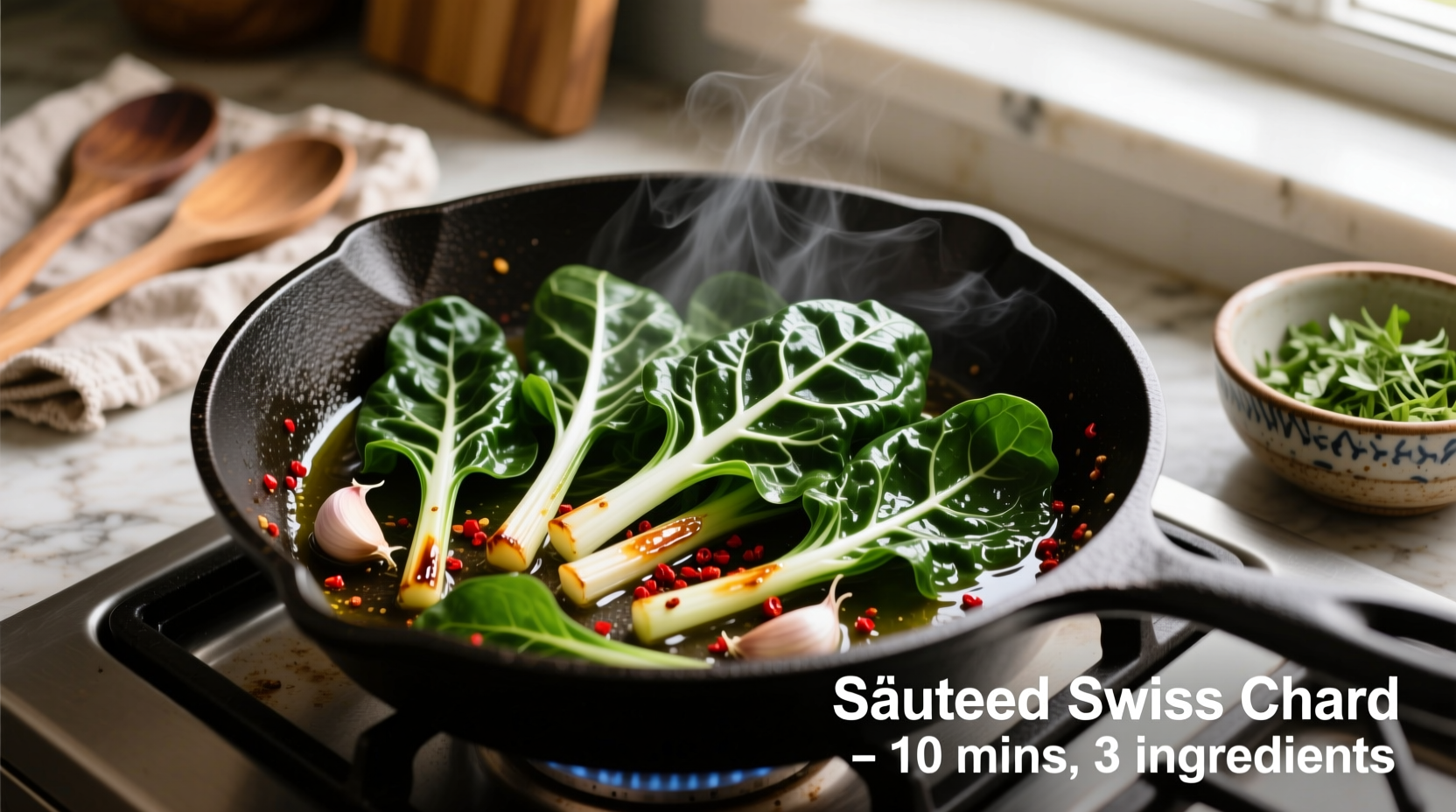If you're wondering how to cook Swiss chard, the simplest and most versatile method is sautéing: wash the leaves thoroughly, separate stems from leaves, chop both into bite-sized pieces, sauté chopped stems in olive oil for 3-4 minutes until slightly tender, then add leaves and cook for another 2-3 minutes until wilted but still vibrant green. This preserves nutrients while enhancing flavor with garlic, lemon, or herbs.
Discover the complete guide to transforming this nutrient-packed leafy green from garden to plate with professional techniques that maximize flavor and texture. Whether you're a beginner cook or seasoned chef, these methods ensure perfect Swiss chard every time—without the common mistakes that lead to soggy, bitter results.
| Cooking Method | Prep Time | Cook Time | Texture Result | Best For |
|---|---|---|---|---|
| Sautéing | 5 min | 6-8 min | Crisp-tender stems, silky leaves | Weeknight meals, garlic lovers |
| Steaming | 3 min | 4-6 min | Firm stems, delicate leaves | Preserving nutrients, mild flavor |
| Roasting | 7 min | 15-20 min | Caramelized edges, tender center | Side dishes, meal prep |
| Blanching | 4 min | 2-3 min | Bright green, crisp texture | Salads, freezing, pesto |
Master Swiss Chard Preparation: The Foundation for Perfect Cooking
Before you even heat your pan, proper preparation makes the difference between exceptional Swiss chard and disappointing results. Professional chefs separate the stems from leaves because they cook at different rates—a technique verified by the University of California Cooperative Extension's vegetable preparation guidelines.
The timeline matters: Start with stems (which take longer to cook) and add leaves later. For mature Swiss chard with thick stems, chop them into 1/2-inch pieces and begin cooking 3-4 minutes before adding the leaves. Tender baby Swiss chard can be cooked whole, but most varieties benefit from this separation technique.

Sauteing: The Most Versatile Swiss Chard Cooking Method
Sauteing delivers restaurant-quality Swiss chard in minutes with minimal equipment. Here's the chef-approved method:
- Wash thoroughly in cold water (dirt hides in crevices)
- Remove tough center ribs from large leaves
- Chop stems into 1/2-inch pieces, leaves into 1-inch strips
- Heat 1-2 tbsp olive oil in skillet over medium heat
- Add stems with pinch of salt, cook 3-4 minutes until slightly tender
- Add minced garlic (1-2 cloves) and cook 30 seconds until fragrant
- Add leaves in batches, stirring until wilted (2-3 minutes)
- Finish with lemon juice or vinegar for brightness
This technique appears in culinary textbooks like On Food and Cooking by Harold McGee, who explains how acid balances Swiss chard's natural bitterness. For optimal texture, never overcrowd the pan—cook in batches if necessary.
When to Choose Alternative Cooking Methods
While sautéing works for most situations, different contexts demand different approaches:
- Steaming (best for nutrient retention): Place stems in steamer basket first, add leaves after 2 minutes. Total cooking time: 4-6 minutes. The USDA Food Safety and Inspection Service confirms steaming preserves more water-soluble vitamins than boiling.
- Roasting (best for caramelization): Toss chopped Swiss chard with oil, spread on baking sheet, roast at 400°F for 15-20 minutes. Ideal when serving alongside roasted meats or vegetables.
- Blanching (best for freezing or salads): Boil stems 1 minute, add leaves for 30 seconds, then plunge into ice water. This technique, recommended by the National Center for Home Food Preservation, stops enzyme activity that causes deterioration.
Avoid These Common Swiss Chard Cooking Mistakes
Even experienced cooks make these errors that compromise flavor and texture:
- Skipping the wash: Swiss chard grows close to soil and traps grit. Fill sink with cold water, swish leaves, and repeat until no sediment remains.
- Overcooking: Leaves become slimy when cooked beyond 5 minutes. Remove from heat when still slightly crisp.
- Adding salt too early: Salt draws out moisture prematurely. Add during cooking, not at the beginning.
- Mixing varieties improperly: Rainbow Swiss chard stems require longer cooking than green varieties. Adjust timing accordingly.
Flavor Pairings That Transform Swiss Chard Dishes
Elevate your Swiss chard with these chef-recommended combinations that balance its earthy flavor:
- Acid components: Lemon zest, apple cider vinegar, or balsamic reduction cut through bitterness
- Aromatic bases: Shallots, garlic, or leeks build flavor foundations
- Umami boosters: Parmesan cheese, toasted nuts, or soy sauce enhance depth
- Spice complements: Red pepper flakes, nutmeg, or smoked paprika add complexity
According to flavor pairing research from the Culinary Institute of America, Swiss chard's earthy notes harmonize particularly well with citrus and nutty flavors. Try finishing cooked Swiss chard with lemon juice and toasted pine nuts for a restaurant-quality dish.
Storage Tips for Maximum Freshness
Proper storage extends Swiss chard's shelf life and maintains quality:
- Store unwashed in perforated plastic bag in refrigerator crisper drawer
- Place damp paper towel in bag to maintain humidity
- Use within 3-5 days for best quality (stems last longer than leaves)
- Cooked Swiss chard keeps 3-4 days in airtight container
The University of Minnesota Extension confirms that storing leafy greens with proper humidity prevents wilting while avoiding excess moisture that causes spoilage.
Nutritional Benefits Worth Preserving
Swiss chard ranks among the most nutrient-dense vegetables. A single cup provides:
- More than 700% of your daily vitamin K needs
- Nearly 200% of daily vitamin A requirements
- Significant amounts of magnesium, potassium, and iron
- Powerful antioxidants like betalains and flavonoids
Research from the American Journal of Clinical Nutrition shows that light cooking actually increases the bioavailability of certain nutrients in Swiss chard compared to raw consumption, while preserving most heat-sensitive vitamins when not overcooked.











 浙公网安备
33010002000092号
浙公网安备
33010002000092号 浙B2-20120091-4
浙B2-20120091-4